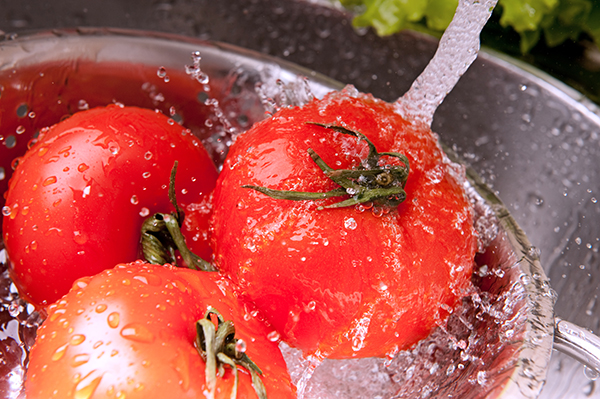Handwashing 101
During the last several months, we have all heard about the importance of hand hygiene. Food service folks have long known that our mothers were right – washing your hands with soap is an excellent preventative step in avoiding illness. Now with COVID, there is more messaging that ever before about handwashing and avoiding cross contamination from unclean surfaces. Those with a tendency for germaphobia (yours truly, by the way) may have noticed this deepening to close to obsessive levels! In fact, carrying one’s own tool kit of disinfecting wipes and hand sanitizer is now the cool thing to do. No surprise that shortages of these supplies at the retail level, along with toilet paper, are voiced loud and clear via social media.
In looking for something positive from the pandemic (we are both glass half full types!), increased awareness about hand hygiene and cross contamination are beneficial outcomes. The how and when of correct handwashing is almost a mantra for those in foodservice. The recipe is to use clean water, later with soap for 10 to 15 seconds, rinse with water, and then dry with either a disposable towel or hot air dryer. While air dryers are environmentally preferred, having a disposable towel handy to turn off faucets, if not automated, and/or open the restroom door to exit and keep clean hands clean is advantageous. Plus, research has shown the abrasion of the towel further reduces microbial load on the hands.[1]
When to wash hands is clearly specified in the FDA Food Code. Per Code, hands should be washed: when entering the kitchen, before beginning food preparation or eating, after touching any soiled item or unclean surfaces, handling raw protein foods, using the restroom, taking out garbage, and working with chemicals. Putting this into practice is a challenge. For instance, a staff member exits the kitchen to use the restroom so hands should be washed in the restroom as well as immediately after reentering the kitchen. Most surfaces in the kitchen area are kept clean and sanitized, but there are the hidden touch points, such as refrigerator door handles, that may not be included in daily cleaning schedules and should necessitate a handwashing after touching. Other surfaces get touched so frequently, it is a challenge to keep them free of any harmful microorganisms. Our former colleague, Dr. Jeannie Sneed, led a couple of research projects documenting microbial loads on different kitchen surfaces, with findings published in several peer-reviewed journals and used in creating the YUCK photos housed on the Iowa State University Food Safety Project web page (available as a free download). Refrigerator handles were found to harbor lots of pathogenic microorganisms in various kitchens!
Another challenge is that jobs may require frequent changes from handling “clean” surfaces (i.e. serving a plated meal) to those that are “dirty”, such as removing soiled dishware from the table and taking to the dish room. This can be especially true for front-of-house staff in full service restaurants. At K-State, Kevin’s group has developed messaging about handwashing that can help reinforce the importance of handwashing. Moreover, FoodHandler has some great videos (each about 5 minutes in length, so perfect for training) about handwashing and other hand hygiene practices.
In the second blog this month, we will discuss some strategies to minimize the need for handwashing occasions, while still maintaining good hand hygiene. Join us for the SafeBites webinar on September 16th for a deeper look about hand hygiene.
Hand hygiene is one way to control from risks of illness. As we say at FoodHandler – Risk Nothing!
[1] Strohbehn, C.H., Sneed, J. Paez, P., & Meyer, J. (2008). Handwashing frequencies and procedures used in retail food services. Journal of Food Protection, 71(8), 1641-1650.
READ MORE POSTS
Emergency Preparedness and Responding to a Disaster with Food Safety in Mind
As I write the first blog this month, the realities of the devastation in Florida are coming to light as we also deal with the aftermath of Hurricane Fiona, which impacted Puerto Rico late in September. Recent news has been focused on the recovery efforts for all who have been impacted. Thus, I thought it would be fitting this month to discuss emergency disaster planning resources in our first blog and delve into recovering from a disaster in our second blog later this month.
During National Food Safety Education Month is it time for Your Food Safety Refresher?
You see them in every restaurant and commercial foodservice operation across the United States. Framed and proudly displayed, often by the kitchen, the cashier, the kitchen entrance, or the service counter - just as they should be. To what am I referring? The food safety certification certificates, of course!
Welcome to National Food Safety Education Month!
In September of each year, we not only have the opportunity to celebrate Labor Day, but we also welcome National Food Safety Education Month! It is this time of the year when it is important to remember that Foodborne illnesses are still a major concern in the United States, although I am guessing many Americans don’t think about the safety of the food they eat as they go throughout their daily lives. The statistics show one in every six Americans will suffer from a foodborne illness each year, for a total of about 48 million cases each year.
Protecting Fresh Produce Post-Harvest, Integral to Safe Food
During the height of the summer, at least in the Midwest, farmers markets are in full swing and fresh produce is plentiful. Every backyard gardener is reaping the benefits of their work, with bountiful harvests of tomatoes and cucumbers. Everyone seems to have a neighbor who is trying to pawn off his or her over-production of cucumbers or summer squash during this time of year. When picking up that produce at the farmer’s market or from your neighbor down the street, have you ever given any thought to the microbial safety of it? Honestly, even in my position, it certainly is NOT the first thing that comes to my mind. But, earlier this month, I came across a news story out of Wisconsin discussing a Salmonella outbreak associated with shelled peas sold at a local farmers market. Who would have thought shelled peas would be impacted? The story noted, and it served as a great reminder, that most outbreaks associated with Salmonella in produce are due to mistakes made in handling or transportation of produce after harvesting.










